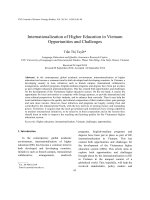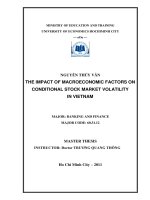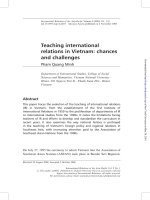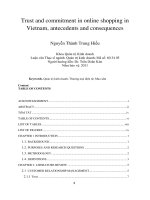Food safety along informal pork market chains in Vietnam –successes and challenges from an integrative research team view
Bạn đang xem bản rút gọn của tài liệu. Xem và tải ngay bản đầy đủ của tài liệu tại đây (1.72 MB, 16 trang )
Food safety along informal pork market chains in Vietnam –
successes and challenges from an integrative research team view
Fred Unger1*, Hung Nguyen-Viet1, Lucy Lapar1, Phuc Pham Duc2 Pham Van Hung3, Pham Hong Ngan3, Max Barot1,
Delia Grace1
1
International Livestock Research Institute, Nairobi, Kenya and Hanoi, Vietnam
Faculty of Veterinary Medicine, Vietnam National University of Agriculture, Hanoi, Vietnam
2 Center for Public Health and Ecosystem Research, Hanoi School of Public Health, Vietnam
3
4th International One Health Congress & 6th Biennial Congress of the International Association for Ecology and Health (One Health EcoHealth 2016)
Melbourne, Australia, 3–7 December 2016
Outline
Food safety and role of pork in Vietnam
PigRISK – approach, key results and challenges
Integrated research team
Conclusion & way forward
Why food safety
WHO’s report: First global estimates of foodborne diseases
- almost 1 in 10 people fall ill every year from eating contaminated food
and 420 000 die as a result
- With 33 million DALYs FBD are of a similar burden in order of magnitude
as the “big three” infectious diseases HIV/AIDS, malaria and tuberculosis
- Children under 5 years of age are at particularly high risk
- African and South-East Asia Regions have the highest
burden
/>disease/fergreport/en/
Food safety – Vietnam
• Food safety among the most pressing issues for people in Vietnam, more
important than education or health care
• Repeated episodes of adulterated and unsafe food
– Pesticides in vegetables, mass fish intoxication, antibiotics residues
– While biological hazards are the most important risk perception towards
chemical hazards
• Reported outbreaks 370 (2014-2015), 66 fatalities, very high
underreporting expected (>1/100)
• Vietnam has a modern food safety legislation system
– Food exports relatively well managed but deficits in domestic markets
• Use of risk based approach and risk communication limited
Background - pork in Vietnam
Pork is an important component of the Vietnamese diet
• More than 70% of consumed meat is pork
• Annual pork consumption per capita in Vietnam: 27kg
• 83% comes from very small or small farms
• 76% of pigs are processed in small slaughtering, nearly 30,000
• Preference for fresh “warm” pork supplied in retail
traditional markets (80% of all pork marketed)
• affordable, address local demands
• often escape effective control
– f
• Consumption of risky pork
products is common
(raw fermented/blood pudding)
Food safety risk assessment along the pork value chain
PigRISK project (2012-2017)
To assess impacts of pork-borne diseases on
human health and the livestock and identify
control points for risk management.
Integrated approach
• Interdisciplinary team
Vets, PH, Economist, Animal Science, Modeller
Study sites
2 provinces
Hung Yen, peri-urban
Nghe An, rural
Pig Risk
- VCapproach
approach
Value
chain
Placed at specific actor along VC based on RA results
Production
Slaughter
Processing
Market
Consumers
From farm to fork
Systems context – actions taken by one affect all.
“Weak links” in the chain may accentuate disease risk – challenge & opportunity
Framework
1
Risk profiling & hazard identification Literature review, PRA, Base line
2-3
Microbial Risk Assessment
4
Chemical Risk Assessment
Biological hazards:
Risk assessment
Salmonella
Animal Health Risk Assessment
spp.
Streptococcus suis
Economics (eg cost of illness)
(Coliform and E. coli)
Synthesis
System dynamics model
Chemical hazards:
Rapid assessment
Value chain
Economic assessment
AB residues
5
Growth promoters
Heavy metals
VIETGAHP
….
6 Engaging stakeholders, advocacy, communication
Interventions
(2017 ++)
Intervention 1
Intervention 2
Intervention 3
PigRISK Selected results
• Biological hazards (Salmonella) are present in the pork value chain and
increase along the chain: 44% in cut pork at retail market
– Highest amplification at slaughterhouse but exposure starts at farm (20%
Salmonella in drinking water for pigs)
– Low priority given to food safety by producers (highest: feed and pig prices)
• Risk for consumer determined
– First quantitative risk assessment for Salmonella in pork for Vietnam
– Around one out of 10 consumers are infected by pork-related salmonellosis
annually
• First cost of illness estimate for pork borne diseases
– Hospitalisation alone was around $6 million per year
• Assessment of chemical hazards in pork
– contrary to public opinion, chemicals studied responsible for little health risk,
but banned substances were present in a few samples.
Intervention development - PIG SLAUGHTER-HOUSE
Pilot trial: Significant
reduction of cofiforms
Source: Unger, 2015
PIG SLAUGHTER-HOUSE – challenges observed
Behavior/practice change
Source: Unger, 2016
Challenge: Missing incentive for safer pork at retailer
PigRISK Integrated research team
Multi-disciplinary research team
established and functioning
What makes it work?
• Involvement of research teams already
as early as in the concept note phase
• Strong recognised expertise, clear tasks, contributions, outputs
identified and maintained
– VNUA Econ team: Value chain, economic assessment and system
dynamics model
– VNUA Vet team: Animal health risks
– HUPH: Public health and biological risk assessment
Integrated research team
What makes it work? cont.
Incentives/gains for the teams
– Capacity building, > 10 training courses tailored to team needs
• VC analysis, system dynamics, risk assessment, >60 students
– Gained recognition which led to new assigments
• VNUA team was contacted by other institutions to conduct “value
chain” courses
• HUPH team involved in establishment of National Taskforce on Food
Safety and WorldBank Food Safety Assessment (2016)
– Track record on publications & scientific recognition
• Joint papers but also room for individual papers
• >10 peer revieived international & > 20 national
– New proposals developed with high chance of acceptance
Integrated research team, cont.
Challenges:
• Turnover of members was high (mainly due to pursuit of higher
studies), leading to delays in some activities
– also a positive outcome, because project members obtained new
opportunities
• Cross cutting analyses of results, time consuming, resulted in
considerable delay of analyses but also publications
Conclusions
• Various challenges related food safety
– Biological hazards (Salmonella) in pork pose a considerable risk for the
consumer
– Situation for chemical hazards less dramatic while public perception focuses on
those
• Strong links to policy makers established
• Inter-disciplinary team successfully established and sustainable
– Success based on clear tasks, outputs and incentives
• PigRISK focused on assessment with many “first” but less progress was
made on risk management
– Will receive specific attention in a currently developed new project
– Several pork value chains (e.g. native pigs, caterers providing pork to industrial
zones, private boutique outlets selling ”organic” pork …)
– Incentive based light touched interventions
Acknowledgment
•
•
•
•
Vietnam National University of Agriculture
Hanoi University of Public Health
Local authorities in Hung Yen and Nghe An
Involved various VC acotrs and groups
Publications in 2016
• Int Jnl PH
• QMRA
• Risk communication (chemical
versus biological)
• Int Jnl for Food Prot
• Perception on food borne
disease









